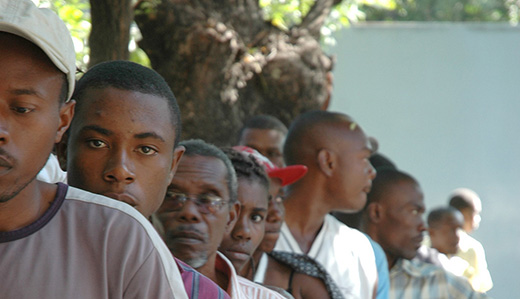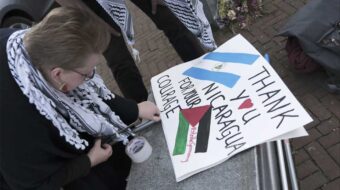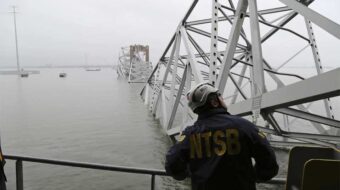
In Haiti, where the U.S. government wages what amounts to low-intensity war, the balance of forces does not favor the people. Successive U.S. governments, once the servant of slaveholders, long ago undertook to clean the Western Hemisphere of popular rebellions. France, the colonial power jilted by a slave rebellion in Haiti 200 years ago, weighs in as needed.
Popular mobilization lifted Jean-Bertrand Aristide to Haiti’s presidency in 1990 and 2000. It impelled thousands of Aristide’s Lavalas Party adherents to accompany him from Port-au-Prince’s airport to his residence on March 18, when he returned from U.S.-imposed exile in South Africa.
Supporters credit Aristide in office with school construction, women’s education projects, health care and medical education initiatives, and AIDS programs. Aristide governments doubled the minimum wage and taxed the wealthy. He demanded France return money extorted for loss of slave property.
After the January 2011 earthquake devastated Haiti, international solidarity mushroomed. Cuba, Brazil and Venezuela fashioned an aid system focusing on construction, education and health care. Namibia, Norway, South Africa, Australia and Spain jointly contributed $350 million. Cuba, having trained doctors and provided medical care in Haiti for a decade, has maintained 1,200 doctors there since the earthquake. They work in 23 hospitals and have carried out 2 million patient visits. Joined by Doctors without Borders, they fight a cholera epidemic projected to cause 11,100 deaths by year’s end.
Yet forces of repression remain fully engaged. Ex-dictator Jean-Claude Duvalier’s return from exile in France on January 16 seemed effortless. Washington was maneuvering meanwhile to block President Aristide’s return. President Obama tried, unsuccessfully, to persuade South African President Jacob Zuma to delay Aristide’s departure.
Haiti’s President-elect Michel Martelly, victor in second-round voting on March 20, actually took third place in the first round. But U.S. Secretary of State Clinton arrived on January 30 to force Haiti’s Electoral Council to implement the OAS Verification Mission’s ruling that Martelly be given a second-place finish, thus enabling him to move into the second round. U.S., French and Canadian representatives dominated on the OAS commission. The Lavalas party had been banned from election participation. Turnouts for first- and second-round voting reached 25 percent and 20 percent, respectively.
Political novice Martelly’s campaign benefited from $29 million in foreign financial backing. He was once affiliated with the murderous “Tonton Macoutes” and, later, with CIA-supported FRAPH paramilitaries. Martelly, a self-described “entrepreneur,” promises Duvalier a role as advisor. He pledged to restore Haiti’s army, disbanded by Aristide for human rights abuses.
Meanwhile, other international earthquake recovery efforts have been playing out beyond Haitian borders. A UN-sponsored donor conference in March 2010 pledged $10 billion in aid, plus debt relief, with $4.7 billion scheduled for delivery within 18 months. Only 37 percent has been disbursed 13 months later. The U.S. has so far handed over only $120 million of its $1.15 billion commitment.
The former U.S. coordinator for relief and reconstruction, Lewis Lucke, claims he helped the Haiti Recovery Group Ltd. gain reconstruction contracts worth $20 million. His lawsuit seeking $500,000 in compensation for the favor highlights the priorities of one U.S. operator. According to the Center for Economic and Policy Research, Lucke traveled to Haiti to ensure the new government works “closely with private local and international donors to ensure prompt delivery and effective use of $10 billion in foreign aid.” But Haitian members of the Interim Haiti Recovery Commission, co-chaired by former U.S. President Bill Clinton, have expressed outrage at being “completely disconnected from the activities of the IHRC.” Haitian organizations are demanding that the commission be dissolved.
Foreign domination involves direct outside military occupation, under United Nations cover. Soldiers and police of the UN’s MINUSTAH contingent, presently numbering 12,200, arrived shortly after Aristide’s removal. UN troops maintain repression of Lavalas activists. U.S. funding covers one-fourth of this year’s $854 million MINUSTAH budget. A U.S. armada showed up off Haiti immediately after the earthquake with thousands of troops going ashore. Some 300 of them returned for the second round of presidential voting.
Military invasion, whether by U.S or UN proxy troops, is in the North American grain. Under U.S. military occupation from 1915 to 1934, Haitian independence fighters were brutally suppressed. Later, invasion and occupation of the Dominican Republic in 1965 were aimed at warding off another Cuba, i.e., another socialist-style revolution. The United States invaded Cuba in 1898 in part to scuttle another Haiti, i.e. “another Black republic.” For Washington, completing the circle may seem logical.
In Haiti, a million people remain homeless with excreta going into open-air pits. As of this January, reports Oxfam, only 5 percent of city rubble from last year’s earthquake has been cleared. Amnesty International reports rampant abuse in displacement camps of women and girls.
Photo: Patients wait in line at the CDTI Hospital in Port-au-Prince, Haiti, in February 2010. Phong Tran / IRIN | www.irinnews.org CC 2.0












Comments